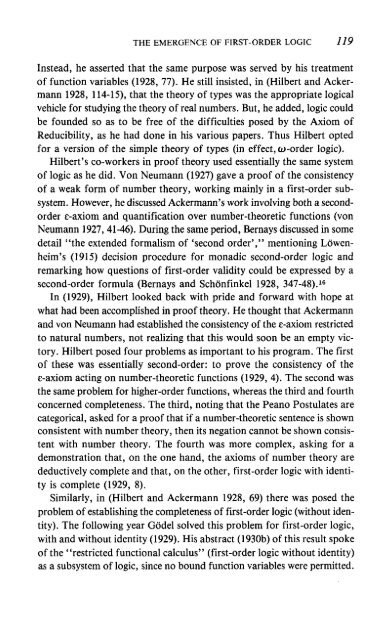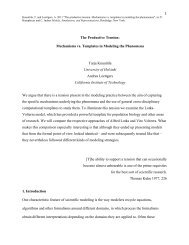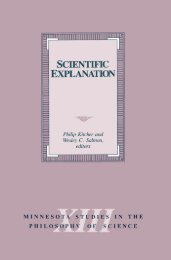The Emergence of First-Order Logic
The Emergence of First-Order Logic
The Emergence of First-Order Logic
Create successful ePaper yourself
Turn your PDF publications into a flip-book with our unique Google optimized e-Paper software.
THE EMERGENCE OF FIRST-ORDER LOGIC 119<br />
Instead, he asserted that the same purpose was served by his treatment<br />
<strong>of</strong> function variables (1928, 77). He still insisted, in (Hilbert and Ackermann<br />
1928, 114-15), that the theory <strong>of</strong> types was the appropriate logical<br />
vehicle for studying the theory <strong>of</strong> real numbers. But, he added, logic could<br />
be founded so as to be free <strong>of</strong> the difficulties posed by the Axiom <strong>of</strong><br />
Reducibility, as he had done in his various papers. Thus Hilbert opted<br />
for a version <strong>of</strong> the simple theory <strong>of</strong> types (in effect, o>-order logic).<br />
Hilbert's co-workers in pro<strong>of</strong> theory used essentially the same system<br />
<strong>of</strong> logic as he did. Von Neumann (1927) gave a pro<strong>of</strong> <strong>of</strong> the consistency<br />
<strong>of</strong> a weak form <strong>of</strong> number theory, working mainly in a first-order subsystem.<br />
However, he discussed Ackermann's work involving both a secondorder<br />
e-axiom and quantification over number-theoretic functions (von<br />
Neumann 1927, 41-46). During the same period, Bernays discussed in some<br />
detail "the extended formalism <strong>of</strong> 'second order'," mentioning Lowenheim's<br />
(1915) decision procedure for monadic second-order logic and<br />
remarking how questions <strong>of</strong> first-order validity could be expressed by a<br />
second-order formula (Bernays and Schonfinkel 1928, 347-48). 16<br />
In (1929), Hilbert looked back with pride and forward with hope at<br />
what had been accomplished in pro<strong>of</strong> theory. He thought that Ackermann<br />
and von Neumann had established the consistency <strong>of</strong> the e-axiom restricted<br />
to natural numbers, not realizing that this would soon be an empty victory.<br />
Hilbert posed four problems as important to his program. <strong>The</strong> first<br />
<strong>of</strong> these was essentially second-order: to prove the consistency <strong>of</strong> the<br />
e-axiom acting on number-theoretic functions (1929, 4). <strong>The</strong> second was<br />
the same problem for higher-order functions, whereas the third and fourth<br />
concerned completeness. <strong>The</strong> third, noting that the Peano Postulates are<br />
categorical, asked for a pro<strong>of</strong> that if a number-theoretic sentence is shown<br />
consistent with number theory, then its negation cannot be shown consistent<br />
with number theory. <strong>The</strong> fourth was more complex, asking for a<br />
demonstration that, on the one hand, the axioms <strong>of</strong> number theory are<br />
deductively complete and that, on the other, first-order logic with identity<br />
is complete (1929, 8).<br />
Similarly, in (Hilbert and Ackermann 1928, 69) there was posed the<br />
problem <strong>of</strong> establishing the completeness <strong>of</strong> first-order logic (without identity).<br />
<strong>The</strong> following year Godel solved this problem for first-order logic,<br />
with and without identity (1929). His abstract (1930b) <strong>of</strong> this result spoke<br />
<strong>of</strong> the "restricted functional calculus" (first-order logic without identity)<br />
as a subsystem <strong>of</strong> logic, since no bound function variables were permitted.




